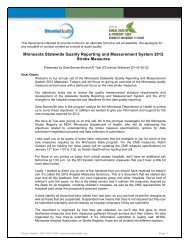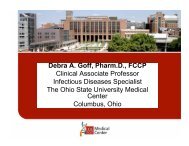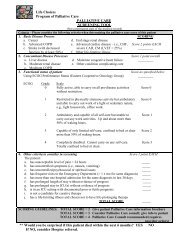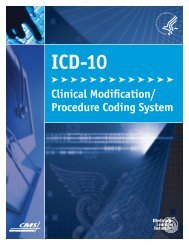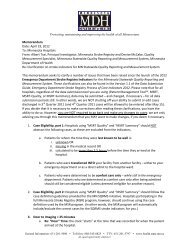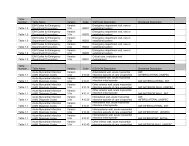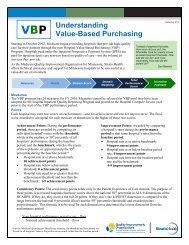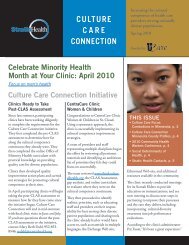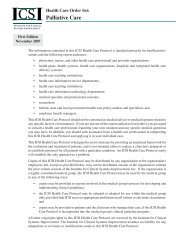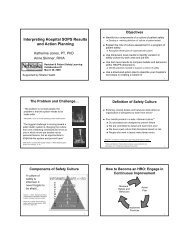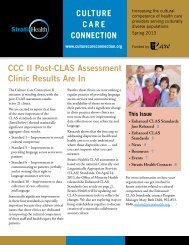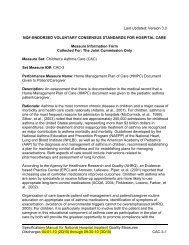Webinar Transcript Template - Stratis Health
Webinar Transcript Template - Stratis Health
Webinar Transcript Template - Stratis Health
Create successful ePaper yourself
Turn your PDF publications into a flip-book with our unique Google optimized e-Paper software.
This transcript is intended to provide content in an alternate format to aid accessibility. We apologize for any<br />
inaudible or unclear content as a result of audio quality.<br />
“Learning and Action Network:<br />
An Introduction and Addressing Issues with Quality Reporting<br />
Presented Dr. Paul Kleeberg; Clinical Director, REACH, Phil Deering; Regional<br />
Coordinator, REACH, Connie Geyer, North Dakota <strong>Health</strong>care Review Inc., and Jerri<br />
Hiniker, <strong>Stratis</strong> <strong>Health</strong>.<br />
(53-minute <strong>Webinar</strong>) 02-29-2012<br />
Jerri Hiniker: Welcome everyone to our first education session webinar, part of the<br />
Learning and Action Network. Today we’re going to be doing an introduction and<br />
addressing issues with quality reporting. I appreciate everybody signing on in the late<br />
afternoon.<br />
Today, our presenters will be Dr. Paul Kleeberg, the Clinical Director at REACH the<br />
regional extension center, and Phil Deering, who is Regional Coordinator, also with<br />
REACH. Connie Geyer, who is a quality improvement specialist with the North Dakota<br />
<strong>Health</strong>care Review Inc., and then myself (with <strong>Stratis</strong> <strong>Health</strong>, the quality improvement<br />
organization for Minnesota).<br />
In our agenda for today, we’re going to start with an overview of the Learning and Action<br />
Network. Then we’ll do an overview of quality reporting for meaningful use, which will be<br />
followed by an introduction to using a new quality reporting system.<br />
Connie and I will start with an overview of the Learning and Action Network. Many of you<br />
may have the question ―What is the Learning and Action Network?‖ You’ve all received<br />
invitations over the past few months inviting you to become part of this learning and<br />
action network, which is a collaborative between REACH and the Minnesota and North<br />
Dakota Quality Improvement Organizations.<br />
The Learning and Action Network stems from the partnership, actually, that came out of<br />
the work for the Quality Improvement organization, work that we’re doing as part of CMS<br />
that we’re contracted to do. What the work was looking at was helping with those clinics<br />
and providers who have already reached Milestone Two, and working with them in the<br />
regional center or REACH to provide further education to those providers and clinics.<br />
A lot of the focus that we’re doing is in a preventive services area. I just want to talk a<br />
little bit more about the prevention project. The focus of this prevention project is<br />
improving help for populations and communities. We started in August of 2011, and it will<br />
run for the next three years, through July 31 of 2014. The specific goal is to provide this<br />
collaborative environment between the QIOs and the regional extension centers and,<br />
Page 1
hopefully, those clinicians who are ready to reach out to welcome the further education<br />
and resources we can offer you to help you optimize your electronic health records.<br />
Many of you on the call have actually probably been part of the work that’s happened<br />
over the last few years with electronic health records at <strong>Stratis</strong> <strong>Health</strong> and what the North<br />
Dakota QIO have been doing as far as helping people get up and running on electronic<br />
health records, but also the preventative services work that we’ve done over the past<br />
three years. This is really an extension of that, while we are looking again at those<br />
preventive service measures, we’ll also be looking at what other measures we can help<br />
you use your electronic health records to the holistic stem.<br />
Connie Geyer: Thanks, Jerri. The Learning and Action Network, like Jerri said, is<br />
relatively a new concept. It’s to help with widespread knowledge, gathering colleagues<br />
from all over the state of North Dakota and with this collaboration, between Minnesota<br />
and North Dakota, to try to share expenses and challenges that we have been facing or<br />
you may have been facing with reporting your quality measures.<br />
It’s a mechanism for fostering large scale improvements. It’s a good way to be able to get<br />
together and share best practices, manage knowledge as a valuable resource, and it<br />
provides opportunities for our communities to harness knowledge, and learn from our<br />
challenges, and share our successes in reporting the quality measures.<br />
Also, many of the meaningful use measures overlap or align some of the other measures<br />
that we will be addressing in the Learning and Action Network. We are actually having<br />
two types of Learning and Action Networks, prevention network which will help offices to<br />
promote prevention services such as influenza immunizations,<br />
pneumococcal vaccinations, making sure we are promoting mammogram screening and<br />
colorectal screening.<br />
Our cardiac Learning and Action Network will focus on some different measures. Those<br />
will include things like managing patients with coronary artery disease or peripheral<br />
vascular disease, making sure their blood pressure is less than 140/90. Patients with high<br />
cholesterol, making sure their cholesterol is less than 100, making sure that patients are<br />
identified as being smokers if they’re receiving smoking cessation counseling. Also, a<br />
patient that has vascular disease, that those patients identified with IVDs that they will<br />
have some type of vascular therapy or antithrombotic therapy under appropriate<br />
conditions.<br />
We also want to promote sustainability and strength. This is something we want to keep<br />
focused on as time goes.<br />
With strategies that we’ll use we’ll be reviewing the educational needs in the clinics. We<br />
understand by talking with several of you that there are a lot of demands. You’re trying to<br />
get your EHRs up and running, trying to pull quality, and you have lots of different things<br />
to report on. By showing you that most of these aims do align, it’s not doing extra work,<br />
it’s just doing the same, sending the reports to other places.<br />
We at the QIOs think we’re a best kept secret that we can come in and help you do that<br />
so that it isn’t any additional burden or frustration on your clinics, because we all<br />
Page 2
understand that there’s limited time that you have to share this information. We want to<br />
provide regular opportunities for collaboration, some of those are listed on your screens.<br />
There are several ways we’ll be doing this throughout the year, we’ll have face-to-face<br />
meetings, webinars like this, and getting together on conference calls. We’ll even do<br />
some online or virtual meetings as well to try to give everyone an opportunity to be able<br />
to share and learn from each other.<br />
We will also be able to go on-site or over the phone, provide technical assistance in<br />
helping you pull this data, helping you to set up your earpieces, how to pull this data,<br />
where to get it from, and how to get these measures reported correctly.<br />
Like I said, we understand your frustrations and we’re here to take some of the frustration<br />
out of this so your quality reporting won’t be quite so burdensome to your practice. We<br />
want to be able to learn from each other, from our successes and challenges, and make<br />
this a sustainable and viable thing for the future. With that being said, I’ll turn it over to<br />
Phil Deering, the Regional Coordinator for REACH.<br />
Phil Deering: Thank you Connie. This morning we’ll take a little time to run through not<br />
the details of quality reporting for eligible professionals to obtaining meaningful use, but<br />
rather some of the issues that have confronted people.<br />
As part of the introduction, I want to say that I know all of us at the regional extension<br />
centers, especially in Minnesota and North Dakota (where a high percentage of providers<br />
in Minnesota aren’t having huge challenges with meeting meaningful use), but we all<br />
know that everyone has challenges with effective use of their EHR. Meaning, using that<br />
technology to make sure that we’re providing better quality, safer care, and, also, running<br />
more efficient operations in our clinics.<br />
This opportunity for the Learning and Action Network allows us at the regional extension<br />
centers to bridge that government bureaucratic requirement for meaningful use to the<br />
effective use that will be able to get at what your patients and providers need.<br />
Like I said, I’m going to do a brief overview of the basics of quality reporting requirements<br />
for meaningful use, and if any of our listeners or participants in the call needs more<br />
information about quality reporting that I don’t touch on, please be sure to contact your<br />
REACH field service consultants. Or, if you’re having trouble figuring out who your<br />
regional service consultants are, get back to any of us on this call and we’ll be able to get<br />
you more details.<br />
Just reviewing the basics of clinical quality measures for meaningful use. First, each<br />
eligible professional– remember, meaningful use is by eligible professional it’s not done<br />
at the clinic level– needs to report on three clinical quality measures from a set of core or<br />
alternate core measures. I won’t go through what those measures are on this call, but at<br />
the bottom of this there is a link to a very good and clear list of those required quality<br />
measures.<br />
In addition to the three core or alternate core, each EP needs to report on three additional<br />
quality measures that come from a list, or sometimes we call it a menu, of 38 clinical<br />
quality measures. The numerators/denominators and exceptions must be those<br />
Page 3
generated by the certified electronic health record technology, which is the key point and<br />
one that often causes people a little confusion. Whether or not you believe those<br />
numbers that are coming out of your certified EHR are correct or not, you need to, in<br />
phase one, report the numbers that appear.<br />
Many of our clients at REACH, when they are confronted with a clinical quality measure<br />
reporting, come to us saying ―Wait, these don’t apply to me. What do I need to do?‖ So,<br />
I’m going to walk through the process, in general, for dealing with the fact that if you<br />
begin to look at core measures what you do. I’ll go through all six steps.<br />
You need to report on three core or alternate core.<br />
If any of the core measures, if your EHR brings those up and you see there is a<br />
denominator of zero so that none of your patients fit the basic requirement to be in that<br />
class, then you need to find alternate core measures where the denominator is not the<br />
zero.<br />
Finally, then you report on all those to get to three where you have a non-zero<br />
denominator. If you have less than three with a non-zero denominator then you have to<br />
report, you have to attest to the fact that all six or all the other six have zero<br />
denominators. Let me walk through with the example of a pediatrician.<br />
If there’s a pediatrician who doesn’t see anyone 13 years or older, it’s clear when you<br />
look at the core and alternate core quality measures that first of all, none of the core<br />
apply because they’re all for adults. Alternate 2 and 3, which are about childhood<br />
immunizations and childhood weight management, do apply. So then the pediatrician<br />
would go ahead and attach to both numerator and denominator and possible exclusions<br />
that are generated by their certified EHR technology. Then finally, they have to go attest<br />
to the other four that they actually have zero in their denominators, because you can’t get<br />
a percentage. In addition, each EP is required to pick three from the list of 38 clinical<br />
quality measures that then apply to them. Again, we’re not going to look through these<br />
but I believe many of you on the call have looked through these, and find that in many<br />
cases you actually have CQMs that your certified EHR technology is certified to report on<br />
and that do apply to your EP.<br />
If your certified EHR technology sometimes, in some cases, will only give you three of the<br />
additional measures. In that case, often none of those apply and then you need to report<br />
zero denominators for all the measures. On the attestation form you will report that I get<br />
zero on all the 38. The EP is not responsible for determining the status of CQM that<br />
certified EHR technology is not capable of calculating.<br />
Dr. Kleeberg: Let me pause you for a moment. It would be clear to have zero in the<br />
denominators for all for which the EHR was pertinent, not all 38.<br />
Phil Deering: Okay. Thank you. That is correct. Basically, you then report those if you<br />
can. If your EHR is capable of reporting all 38 but none of them apply to you, then you do<br />
need to attest for all those that your EHR can generate that you would have zero<br />
denominators. Therefore, the goal is to report six non-zeros or attest to the fact that you<br />
have zero denominators to make up to that six.<br />
Page 4
When this initially came out and our clients started to attest to CQMs, there were a<br />
number of cases where our clients were looking at the numerators and denominators with<br />
the percentages that were being generated. They realized that these were not accurate<br />
reflections of what their patient populations were truly demonstrating or, what would be a<br />
true measure of that quality measure.<br />
When they looked a little deeper they realized that the workflow they were following,<br />
which was absolutely appropriate for their clinic and patients, was not workflow that their<br />
EHR vendor required in order for all the data to be accurately reflected. CMS recognized<br />
this and put out a clarification that right now in stage one, they do not expect clinicians to<br />
change workflows to get data into the EHR so the CQMs accurately reflect what’s going<br />
on in the clinic.<br />
Instead, the law makes it very clear that the requirement is to report percentages that are<br />
generated by the certified EHR technology. So, whether or not those percentages are<br />
accurate you need to report those percentages, and, certainly, don’t change a good<br />
workflow that is working for you and your patients, so as to accommodate an awkward<br />
workflow that is inherent in the EHR technology.<br />
Over time there is clearly an expectation that you would contact your vendor, talk about<br />
this and recommend to your vendor that they develop a better work flow or over time<br />
perhaps you will be able to switch to the workflow that the vendor recommends.<br />
The other question we receive a lot again comes from a change in the requirement and,<br />
initially, when the meaningful US regulations came out it said that clinical quality<br />
measures will be done by attestation, meaning that you go into the attestation site and<br />
put in numerators and denominators, but you don’t transmit that electronically.<br />
However, there was an expectation that in 2012, these measures would be reported<br />
electronically. That is no longer the case. There is potential to sign up for a pilot program<br />
where you would use PQRI or PQRF reporting mechanisms to also report your measures<br />
electronically from your certified EHR technology, but in most cases, most of the EPs that<br />
we’re seeing are just going to stick with the attestation sites. Actually, we haven’t worked<br />
with anybody yet who has joined in the pilot, I don’t believe.<br />
Those are available if somebody is eager to be part of a pilot, please contact REACH and<br />
we will work to see if those pilots are still open. Basically, I think our best guidance is to<br />
stick with what we have already because it’s pretty straightforward.<br />
Some of you have EHR technology that has a vendor with more CQMs available, but the<br />
vendor didn’t pay to get them all tested because they have to pay additional money for<br />
that. CMS has put out an FAQ clarifying this, which is 106.9 and if you believe, if your<br />
vendor has told you yes, we actually have CQM reporting embedded in our technology<br />
it’s just not certified. You can go ahead in phase one and use that and report to those<br />
CQMs. This will only be in the case of additional of those 38, not in the core six which all<br />
certified electronic health record technology must be able to generate.<br />
Page 5
I’m going to invite Dr. Kleeberg to comment on this. All of us are madly looking at the<br />
regulation and it’s another 500 pages without your details, but certainly I know Dr.<br />
Kleeberg and I have looked at some of the tables which you can begin to understand.<br />
The first and, we think best news is…‖We’re committed to aligning quality measurement<br />
and reporting among our programs,” meaning CMS. So, IQR, PQRF, CHIPRA, ACO, all<br />
those things and we know there is a strong effort and the highest levels of the ONC and<br />
CMS understand that this is not acceptable and are moving towards normalizing it and<br />
bringing all these measures together so there can be more straightforward reporting.<br />
Second, my understanding in looking at it is that in stage two there will be 12 measures<br />
required for each EP to report on, and there’s some question that there will be 12<br />
mandatory or 11 plus 1 menus, which I saw somewhere in the measures. I went through<br />
and tried to read to count, and I came up with 81 new additional measures that were<br />
there. It’s quite a fascinating list, and probably some of you have also looked, but clearly<br />
they are extending it across many specialties.<br />
There were ones on NFG, radiology, a number on dementia care, optometry, mental<br />
health, all sorts of new measures are being added, and I think that’s an important step<br />
forward, to make sure that we’re not just limiting these to the classic primary care quality<br />
measures.<br />
There is no view of in stage two that there will be penalties or incentives paid for reaching<br />
certain percentages of quality measures. There is quite a bit of language in the proposal<br />
for stage two, where there is recommendation that the clinical decision support rules in<br />
the EHR for the EP, than would be aligned with quality measures that those EPs are<br />
trying to obtain.<br />
Again, I think a positive step forward instead of turn on any clinical decision support, but<br />
instead turn on clinical decision support mechanisms that will encourage or push you in<br />
the right direction towards the quality measures you’re trying to obtain. That’s all I have.<br />
Jerri Hiniker: Now we’ll turn it over to Dr. Paul Kleeberg who will be doing an<br />
introduction to using quality reporting.<br />
Dr. Kleeberg: Thank you. To some extent I think I may be preaching to the choir a little,<br />
because I think many folks recognize, at least in Minnesota and North Dakota, that the<br />
only way you’re able to judge the type of care that you’re providing is if you actually<br />
measure what you’re doing.<br />
The interesting thing is if you ask any provider, and this is how it was in my clinic before<br />
we had quality measures, we all believe that we provide care that’s above the average.<br />
We all provide good care.<br />
The question then becomes, if you really want to create change, how do you create<br />
change without actually creating the need?<br />
By looking at quality measures and allowing people to see what they’re doing and how<br />
they’re doing it, it gives them the opportunity to compare themselves with what they think<br />
Page 6
they’re doing, compare themselves with others and also give them some motivation for<br />
change.<br />
We as providers, be we physicians, nurse practitioners, physician assistants, we’re all a<br />
fairly competitive bunch, so when we see we’re not doing as well as we think we should<br />
be we try to strive to do better. Giving us information is something that can help us to<br />
begin to feel the motivation for change within ourselves.<br />
Anyone who has shown their providers quality reports will attest to the fact that one of the<br />
first things that they hear from the providers is, ―My patients are different and these<br />
numbers don’t really reflect the type of care that I’m giving. It’s wrong.‖ There are lots of<br />
gnashing of teeth and hollering, and that is how it was in my clinic when our diabetes<br />
numbers first came out. Interestingly enough, over time the numbers gradually began to<br />
improve and the quality of care gradually improved, which still had people complaining<br />
but it was interesting because they began paying more attention to it.<br />
The next slide is from a clinic up in northern Minnesota. They’ve been on EHR for some<br />
time. They weren’t at meaningful use yet, because their vendor wasn’t really a<br />
meaningful use EHR, at this point in time, so what you’re looking at is a document they<br />
would print every quarter.<br />
Right now you’re looking at the third quarter data for 2010, and these are for patients who<br />
either have high blood pressure and have or don’t have cardio vascular disease. The<br />
ones in red are those that have cardio vascular disease. So if you look under the first<br />
column called organization you’ll see two number 3s. One is red and one is black. The<br />
red number 3 is the third quarter for those with cardio vascular disease and the black 3 is<br />
for those in that third quarter without cardio vascular disease.<br />
What you can see is we’re looking at the organization-wide number. On the top left is 681<br />
patients with cardio vascular disease and hypertension, reported 18 without cardio<br />
vascular disease and hypertension and the next three columns break it down by clinic. In<br />
the last column, you see this one particular provider they’re calling Dr. Blue. I don’t think<br />
he’s blue because he’s holding his breath, he just happens to be called that.<br />
If you look down the left you see, for example, if we go to one LDL less than 100, which is<br />
what’s indicated for patients with hypertension and cardio vascular disease, the<br />
Minnesota State average is 64%. There is no recommendation for Minnesota for those<br />
without cardio vascular disease. Organizationally, the organization is not doing as well as<br />
that of the state average they only have 29%. If you look at clinic one, it’s 32% for those<br />
with cardio vascular disease, clinic two has 21%, clinic three 17%, and clinic four has<br />
45%, still below the average, but significantly above the rest. As you can see, Dr. Blue is<br />
also above the rest in terms of his keeping LDLs below 100 for patients with cardio<br />
vascular disease and hypertension.<br />
This allows a couple things to happen. First, the different clinics can talk to each other<br />
and find out what process they’re using or what each other is doing, so they can begin to<br />
learn new workflows on how this stuff can be accomplished. Also, potentially, Dr. Blue<br />
has the opportunity to say ―Wait, people are doing better in my group like that, maybe I<br />
Page 7
need to talk with some others in my group.‖ Then if you go down the page you can see<br />
they’ve done that.<br />
The third one is LDL no LDL for patients with cardio vascular disease and hypertension.<br />
You can see that organization-wise 22% of the people had no LDL and again, clinic one<br />
was 25%, two was 34%, three is 23%, and again, clinic four seem to be doing better with<br />
6% where there was no LDL on file. Obviously, you want your LDL on file with patients<br />
having cardio vascular disease and high blood pressure.<br />
So, again, this is an example of how you can look across the clinics and prepare the two.<br />
Let me draw your attention to just one more. The very last one: no aspirin documented.<br />
Again, most people seem to have either the fact that they’re on aspirin or they aren’t or<br />
they have a reason for not being on aspirin. We have 6% for those (organization-wise),<br />
2% for clinic one, 7% for two, 14% for three, and 4% for four.<br />
Just looking at these numbers briefly you can see there’s a bit of a difference between<br />
clinics three and four, and given this analysis there is some good opportunity for clinic<br />
three to potentially learn from clinic four. How could you do this without the data?<br />
The next line is, over time for the first three quarters for the 2010, and this is patients who<br />
are tracked with their PF29 (their depression screens). If you look, the bottom line is the<br />
total patients who have depression, and you can see, organization-wise, it’s 484, 479,<br />
423, declining a little bit. Depression declines a little through the summer and into fall,<br />
which is good. But by fourth quarter it’s back up again.<br />
If you look at the percentages of PF29s that were accomplished, again you see 36, 42,<br />
49 organization-wide, so maybe just by looking at it they’re actually beginning to pay<br />
attention to it and do it more. You see the trend and clinic one goes from 34 to 44 and 54,<br />
clinic two 19 to 31 and 36, clinic three had a little bump 52, 63 and 47, and clinic four 40<br />
to 56 and 72. Again, you can see a trend going in an upward direction by and large,<br />
except for the blip on clinic three. So again if you begin measuring things and pay<br />
attention to things, you can begin to achieve your goals and objectives, consequently<br />
improving the care for the patients you’re seeing.<br />
The other thing that quality reports allow you to do is it allows you to drill down to find<br />
those people who have fallen through the cracks. As a provider, before an EHR, before<br />
running reports you could say I ordered A1Cs on every one of my diabetics that come to<br />
see me. The question is, what about the ones that don’t come to see you? Those are the<br />
people that sometimes may forget or miss their appointments. They need a reminder to<br />
come back in.<br />
So if you look at the next slide you can see these are diabetic patients with a diabetic<br />
report for a particular physician, and if you look at the fourth line is someone who hasn’t<br />
had an LDL done in a while, they haven’t had an A1C and their blood pressure is 164/82,<br />
not good. That would be someone you might want to call to say ―Hey, we’d like you to<br />
come in for appointment. You haven’t been in for a while and we want to make sure<br />
you’re doing okay.‖<br />
You can also see that there are some here doing very well and I’m surprised to see an<br />
LDL at 42. That’s awesome! There are a couple others very similar, so by and large this<br />
Page 8
panel is looking very good with blood pressures below 120 on many and that they’re on<br />
aspirin. Again, there are a lot of opportunities to see what’s missing, to call in the patients<br />
that need to be seen and you can better manage your entire panel. This is one way you<br />
can manage population, by reaching out to individuals and having them come in for care.<br />
So, those particular reports, the way they were accomplished is that a group of clinics got<br />
together and hired a part-time person to write the reports within their EHR. There is the<br />
opportunity to do that if you’re sharing a platform with someone else. You could<br />
potentially get grouped together, try to figure out how you can get the reports you want<br />
out of your EHR and begin to write those reports. That’s one methodology and that<br />
worked rather well for that clinic.<br />
Another methodology could be to use the current meaningful use reports that you have in<br />
your EHR that Phil was talking about. There are two reports you can see, one is on the<br />
criteria which are the engines that feed the quality report. You aren’t going to know about<br />
your patients and whether or not they’ve had an A1C drawn if they’re diabetic if you don’t<br />
have diabetes on the problem list. You won’t know if they’re hypertensive and see if their<br />
blood pressure is right without hypertension on the problem list.<br />
So again, you want to track to make sure, these are rudimentary right now because all it<br />
is looking at is to see if there’s one problem on the problem list, but at least it’s a start and<br />
you can begin to identify people that need help in completing the EHR.<br />
Then, when you look at the quality measures you can see places that aren’t going to be<br />
100% accurate, but a good EHR will allow you to drill down on your quality measure to<br />
see who you’re missing. So again, you can begin to approach them and find out if they<br />
want to come into the clinic because they need some particular values and elements<br />
done.<br />
This is another way that you can leverage those calling measures that are installed within<br />
your certified EHR technology.<br />
Those are two ways you can begin to use your quality reporting:<br />
1. Potentially have someone build some of the quality reports for you and hire someone<br />
to build and share it with your groups<br />
2. Begin to identify the quality reports within your EHR, and begin to drill down into them<br />
to make sure the problem lists and medication lists, etc., are filled out, and that people<br />
are working well in keeping, completing, and doing work on their quality measures<br />
Finally, how do you go about doing this?<br />
You don’t want to all of a sudden do this bang, because it’ll be a big surprise, there’ll be<br />
some concerns and maybe the numbers aren’t accurate. The best way I would suggest<br />
you approach it would be for you to run the numbers yourselves a few times. Look at the<br />
data, drill down, and see if it begins to make sense using the reports for the meaningful<br />
use or if you’re able to have some of the ones you’ve had built.<br />
Page 9
Once you’re pretty satisfied that they look okay then I would share them with the group as<br />
a whole. Show the data for the clinic as a whole and then show the data for each<br />
individual, but hide who is who, so you don’t know who is getting what numbers. Give the<br />
provider the key so they know where they fit on that chart. Allow that to run a few times,<br />
and give them some opportunity to modify their numbers to improve, because they will<br />
make some changes when it’s anonymous.<br />
Then, finally, and set a date for when this happens, have those numbers be absolutely<br />
public to the other staff and providers within the clinic. Again, that allows them to find out<br />
who’s doing well. And rather than to be something judgmental, they can go to another<br />
person and say what are you and your nurse doing? How are you making this work so<br />
well? Help me understand, because that’s the best way to be able to share knowledge<br />
and improve things if other people can see whose succeeding and who may need some<br />
help.<br />
Eventually, they’ll probably be revealing these numbers to the world at large, so it would<br />
be better for us to begin this from working not only internally but also externally. To<br />
reiterate what Phil said earlier, the current cloning measures within the EHRs you’re still<br />
not rated on the numbers. That will be true for stage one, so even if you have horrible<br />
quality measures it won’t matter because it’s not published.<br />
Stage two, the proposal is that it would be the same. They don’t expect to rate you on<br />
your numbers and they aren’t expecting to publish them. That’s not true for stage three.<br />
For stage three there will be expectations of improved quality, and I think by that point in<br />
time it will be revealed. So, again, better to start now to become comfortable with<br />
measuring quality, comfortable with processes to improve quality, while you can do it in<br />
the privacy of your own clinic before revealing it to the world at large.<br />
With that, I think I will close and open up for any discussion and questions.<br />
Jerri Hiniker: We sent out discussion questions earlier, but also I would make sure if<br />
people have questions for Dr. Kleeberg or Phil they should feel free to ask those while<br />
we’re here.<br />
Dr. Kleeberg: One of the questions I have for the people on the call is this: ―I’m curious<br />
to know how many are ready to do quality measure stuff like this and how many out there<br />
have actually found some success and have been able to move the bar, as a result, of<br />
using quality measures?‖<br />
Phil Deering: Jerri, you can pull up to see if anyone might be willing to speak up.<br />
Jerri Hiniker: One of the things we’re wondering in fact is this. It’s your time to share<br />
lessons learned with other clinics or find out from other clinics and providers what they’re<br />
doing, so if any of you out there have done some quality reporting or have seen how<br />
using a quality report can show improvement, we’d appreciate you sharing that<br />
information.<br />
Guest: Not as much a question but a response to the question asked. We do have some<br />
issues with some of our quality reporting, but what we’re really focusing on is making<br />
Page 10
sure that our measures are accurate that are being pulled from our EHRs so that they’re<br />
meaningful for our providers. We’re benchmarking ourselves off those measures and<br />
trying to improve our overall processes to continue to improve those measures. The other<br />
thing that’s a little bit of a frustration for us is that we report several measures that aren’t<br />
all identical and so the EHR is only going to pull certain data for us. We’re trying to use<br />
some business object report mechanisms to report the different types of data that we<br />
have to report for different entities.<br />
Phil Deering: That frustration is just really widespread, especially in Minnesota and<br />
North Dakota. For Minnesota, for example, providers are required to do a set of<br />
Minnesota Community Measurement Reports, some of which are a little tick off of the<br />
meaningful use report. And then, in addition, many of the payers are requiring another set<br />
of quality measures be given to them, which are a third tick off of what the other two<br />
were. So it’s important that those of us working with this push for rationalization and<br />
normalization, and best practice, so that this improves.<br />
Guest: I was just going to say this is my first year with getting involved with quality<br />
reporting and what we have found, when you talk about data extraction from the EHR, is,<br />
boy, that we have lots of work to do there! Getting sure you’re capturing your data<br />
appropriately. I think once we get it electronically, this will be quite a snap to pull that<br />
data. This manual extraction was really a crazy thing for us last year, which was the first<br />
year, so we did learn a little bit from that as far as our electronic medical record goes. We<br />
were able to make some changes from last year which helped us this year. You talk<br />
about the quality piece of it, but also improving your electronic health record goes in<br />
tandem with each other.<br />
Phil Deering: Initially, were you being required to have providers to suddenly go three<br />
screens over and then click a box or those sorts of things that would cause resistance in<br />
their workflow? Or even, were other users having to come into a process that was being<br />
done by the roomer, but suddenly the EHR wasn’t picking that up unless it was done by<br />
the MD? Did you run into any of those situations?<br />
Guest: We ran into situations where we actually had to create fields and then put those<br />
fields in and try to develop them in their workflow of their electronic form. We had to<br />
customize and tweak things. It did make a change and continue to make changes in their<br />
workflow and processes.<br />
Dr. Kleeberg: That’s an interesting point you make, because I think those of us who<br />
have been using the EHR for some period of time, have created all those custom dated<br />
capture mechanisms to be able to measure diabetes care, hypertension, and all those<br />
things accurately. And then– those techniques haven’t turned out to be the same spots<br />
that– to try and collect that information. I know ONC in their new standards and<br />
certification criteria for EHRs is aware of that issue and wants to begin to repair that<br />
damage in the next go round of EHR certification.<br />
For right now, it’s still what’s slowing many people down who have established EHRs,<br />
because now providers are saying you want me to document this where. As Phil was<br />
saying earlier, it’s not in the workflow so they’re not documenting it and the numbers don’t<br />
seem accurate.<br />
Page 11
Guest: Yes, and it’s not that they don’t want to do their jobs or capture the status, it just<br />
slows them down so much, they become frustrated with it.<br />
Phil Deering: Thank you those comments are very helpful.<br />
Guest: Thank you.<br />
Guest: I just wanted to mention that we have not started quality measures or anything,<br />
but it sounds like a lot of people have already done that. We have not, but I do think that<br />
gathering the data abstraction seems to be somewhat of a challenge. We found that on<br />
the hospital side.<br />
Dr. Kleeberg: What stage are you at with your EHR? Do you have an EHR? Are you<br />
using it to some extent?<br />
Guest: Yes, we’re using it. We actually installed it in 2009, but we’re with <strong>Health</strong> Land<br />
and they don’t have—the clinic site is not certified yet.<br />
Dr. Kleeberg: Right.<br />
Guest: They haven’t moved forward with that too much.<br />
Dr. Kleeberg: I’d be interested in hearing others opinions, but I would say, even though<br />
you’re not fully implemented. if you are able to run any quality measures and look at<br />
them. You obviously don’t want to publish them or anything, but it may begin to give you<br />
some ideas of areas where you might want to put some extra energy or other work. I<br />
recognize it wouldn’t be complete, but, nonetheless, I think we’ve found it viable for<br />
people to run them once a month just to see how they’re progressing.<br />
Phil Deering: The other thing to bring up is that, like <strong>Health</strong> Land, for example, the next<br />
version, the ambulatory version, it’s still in the process of coming out. And, once again,<br />
whatever folks can do in their <strong>Health</strong> Land user groups to get their heads together and<br />
say this is what we need. These are rational workflows you need to give us so that our<br />
providers then can actually, in the normal course of their interaction with a patient,<br />
capture the data that’s required and get accurate reports.<br />
I know for all vendors these are challenges, because if you look at what underlies a<br />
report it’s a massive amount of data to be looked at, and there are many rules associated<br />
with that data. Nonetheless, let’s continue to push for a rational workflow that will allow<br />
these data points to be captured in normal interaction without people having to stand on<br />
their heads or develop new custom forms that lay on top.<br />
Dr. Kleeberg: The question I’d like to look is the last bullet…How would you like to see<br />
this Learning and Action Network assist you in the work you’re doing to improve quality?<br />
Guest: I guess what I’m looking for out of this network is just what you’re providing to us<br />
with the networking, webinars. If we hit some roadblocks, maybe some troubleshooting<br />
Page 12
together would be good, bouncing ideas off each other. I find that huge and think that<br />
being my first year I’ll need a lot of that from others. Thank you for offering this to us.<br />
Dr. Kleeberg: That is precisely what we want this to be. We will be looking for ideas and<br />
see how we can make that happen going forward. It can sometimes be a challenge, there<br />
are PowerPoints, telephones, and things, so any ideas that you or any others have on<br />
how we can improve this to make sure we do meet your needs, we are very open to that.<br />
We’re figuring out our way along here too.<br />
Guest: I just want to say I agree, I thought this was a good introduction right here, and I<br />
think as we continue to move on, this is going to be very helpful in troubleshooting. Thank<br />
you.<br />
Dr. Kleeberg: Glad to hear it.<br />
Guest: I’d like to say if we could possibly have a list of all the participants on these calls<br />
in order to do this networking. One of my thoughts is to share templates. Each of us has<br />
a separate EHR. Let’s see how each other utilizes the templates. Maybe share a<br />
workflow process with each other too, because one clinic might do something a little<br />
different that each of us could learn from. Those are my thoughts on how we can network<br />
and share things with each other.<br />
Dr. Kleeberg: Perfect, great.<br />
Phil Deering: One other thing to share, too, as sort of training materials, as you change<br />
those workflows some people may have some best practices around town alerting<br />
everybody to the new workflow, explaining why you’re doing it and then what the actual<br />
step-by-step instructions are to accomplish those new tasks.<br />
Jerri Hiniker: Again, thank you everyone. I’ve put up our contact information in case you<br />
have any questions. Feel free to get in touch with your consultant through REACH. Thank<br />
you everyone for participating today. Have a good day.<br />
This material was prepared by <strong>Stratis</strong> <strong>Health</strong>, the Quality Improvement Organization for Minnesota, under a contract<br />
with the Centers for Medicare & Medicaid Services (CMS), an agency of the US Department of <strong>Health</strong> and Human<br />
Services. The contents presented do not necessarily reflect CMS policy. 10SOW-MN-C9-12-09 040312<br />
Page 13



